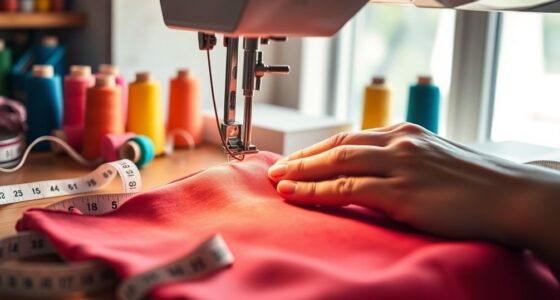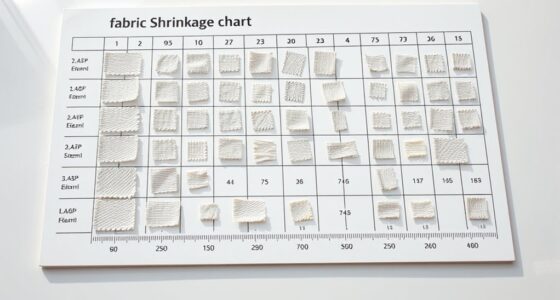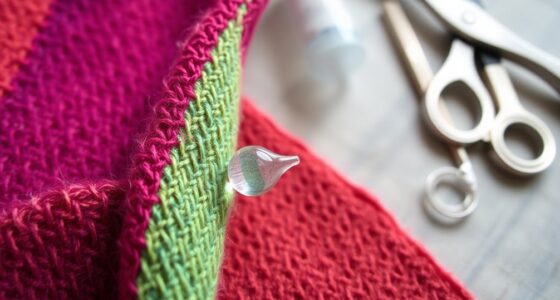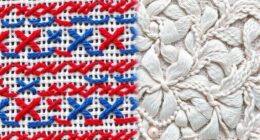To start using a serger, first set your fabric and thread it following your machine’s guidelines, paying attention to tension and stitch length. Adjust the tension so your stitches are balanced—test on scrap fabric and make small tweaks. Choose the right stitch length based on your fabric type, with shorter stitches for lightweight fabrics and longer for heavier ones. Practice controlling the fabric as you sew to achieve neat, professional edges—more tips will help you master your serger even further.
Key Takeaways
- Set the serger’s stitch length between 2-3mm based on fabric type for neat overlocked edges.
- Adjust tension controls gradually, testing on scrap fabric until stitches are balanced and secure.
- Thread the machine correctly, following color-coded guides for each thread to ensure proper overlocking.
- Use the differential feed to prevent puckering or stretching, especially with lightweight or stretchy fabrics.
- Practice on scrap pieces, adjusting tension and stitch length to achieve professional, durable overlocked edges.

Have you ever wondered how to achieve professional-looking seams and finishes quickly? Using a serger, also known as an overlocker, can transform your sewing projects by giving them neat, durable edges in a fraction of the time it takes with a standard sewing machine. The key to mastering a serger starts with understanding two essential settings: thread tension and stitch length. These controls influence the quality of your overlocked edges and help prevent issues like puckering or uneven stitches.
When you begin, focus on adjusting the thread tension. Proper tension ensures that the threads pull evenly and create a balanced stitch. Too tight, and your fabric might bunch or pucker; too loose, and the stitches could unravel or appear loose and uneven. To find the right tension, start with the manufacturer’s recommended settings, then test on scrap fabric similar to your project. If the stitches look loose or the edges are fraying, tighten the tension slightly. Conversely, if the stitches are puckering or the threads are too tight, loosen the tension a bit. Adjusting tension might seem tricky at first, but with practice, you’ll develop a feel for the right balance, resulting in clean, professional finishes.
Adjust tension gradually for balanced, professional seams.
Next, set your stitch length appropriately. Unlike a regular sewing machine, a serger’s stitch length controls the width of the overlock stitch, which affects how tightly the edge is wrapped. For most fabrics, a stitch length of 2-3mm works well, but you can adjust depending on the fabric’s weight and type. For lightweight fabrics, a slightly shorter stitch can help prevent puckering, while thicker materials might require a longer stitch length to avoid bulky seams. Remember, the stitch length also impacts how much fabric is trimmed during the overlocking process. Shorter stitches produce a tighter, more secure finish, while longer stitches can be quicker and suitable for less delicate fabrics.
Additionally, understanding the color accuracy of your serger’s thread and fabric combination can help you achieve more visually appealing results. As you practice, pay attention to how these settings interact. Always test on scraps before starting your actual project. Adjust the tension gradually and observe how the stitches behave, then tweak the stitch length accordingly. Once you’ve dialed in the right tension and stitch length, you’ll notice your seams become more consistent, and your edges will look professionally finished. Using a serger efficiently is all about patience and fine-tuning, but mastering these basic settings makes a significant difference in the quality and speed of your overlocking. With time, you’ll confidently produce neat, durable edges that elevate your sewing projects to a professional level.
Frequently Asked Questions
Can I Use a Serger for Quilting Projects?
Yes, you can use a serger for quilting projects, especially for quilt binding and fabric layering. It’s great for finishing edges quickly and neatly, giving your quilt a professional look. Just make certain you adjust the tension and stitch settings for thicker fabrics. A serger helps secure seams and creates clean, durable edges, making it a handy tool for various quilting tasks. However, it’s not ideal for quilting stitches or piecing the top layer.
How Do I Troubleshoot Tension Issues?
Your serger’s tension issues can feel like a wild beast, but don’t panic! Start by checking the thread tension to guarantee it’s balanced on all four threads. If stitches look uneven or loose, adjust the tension dials gradually—small tweaks make big differences. Consistently monitor stitch quality, and rethread if necessary. With patience, you’ll tame that tension troublemaker and achieve smooth, flawless overlocked edges every time!
Is a Serger Suitable for Delicate Fabrics?
A serger is suitable for delicate fabrics like silk or chiffon if you adjust the stitch settings and use the correct needles. You should choose fine, sharp needles and lower the tension to prevent damage or puckering during delicate sewing. Test on scrap fabric first to verify smooth overlocking without compromising the fabric’s integrity. Proper adjustments make a serger an excellent tool for finishing delicate fabrics professionally.
What Maintenance Does a Serger Require?
You should regularly maintain your serger to keep it running smoothly. Start with threading tips to make certain proper tension and stitch quality; this helps prevent issues. Also, replace needles periodically to avoid skipped stitches and fabric damage. Clean the lint trap and bobbin area often, and oil moving parts as needed, following your machine’s manual. Proper maintenance ensures your serger stays reliable and produces professional results every time you sew.
Can I Sew With a Serger Without a Coverstitch?
Yes, you can sew with a serger without a coverstitch machine. It’s perfect for sewing with knits, providing professional-looking edges and seams quickly. While a coverstitch offers a clean, stretchable finish for hems, your serger can handle most sewing tasks, including decorative stitches, giving you versatile options. Use your serger for constructing garments and adding decorative touches, even without a coverstitch machine.
Conclusion
So, now you’re practically a serger pro—congratulations! Who knew that mastering overlocking edges could turn you into a sewing superstar? Just remember, with great stitch power comes great responsibility… or at least less fraying. So go ahead, impress everyone with your flawless seams. And if all else fails, just pretend your serger is a spaceship and you’re boldly going where no sewer has gone before. Happy overlocking!








